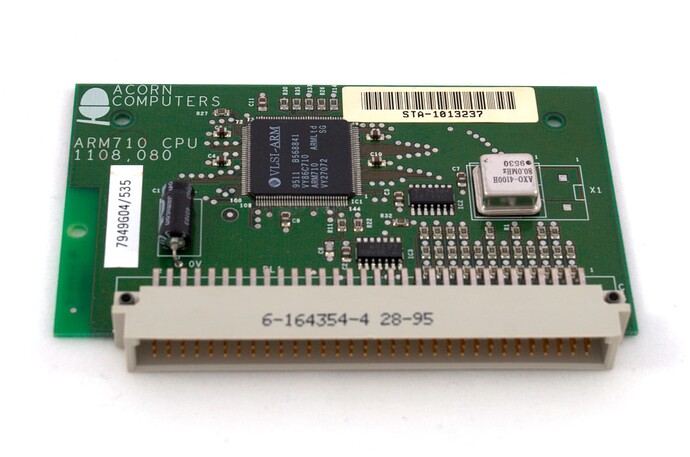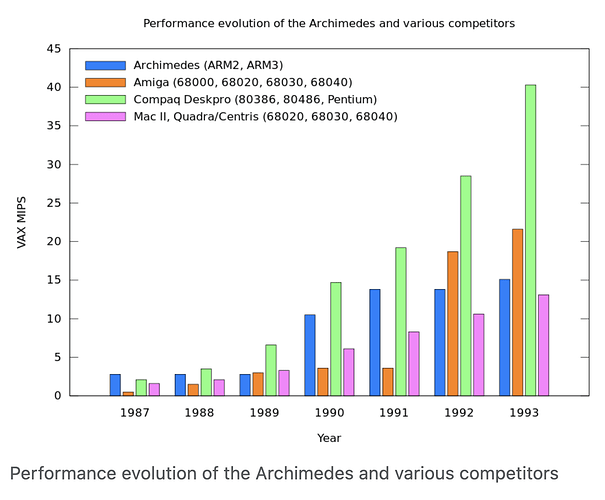There’s a long Usenet thread which has a few posts of note. It starts off with Chris Cox, an Acorn marketing person asking, in April 1995:
To prepare for the release of the 700 upgrade cards during the second quarter (ish) I want to make sure that we get the right number and mixture. So I am looking for some indication of how many existing users feel that they will upgrade to a new card, and whether it will be to the 710 integer only card, or the higher cost 700 card with the FPA (Floating Point Accelerator)
Here’s flibble’s photo of the eventual product, CC-BY-SA
It seems to me like a poor idea to ask a question like this on Usenet - you won’t get representative results and you’ll probably get some unhelpful commentary and awkward questions. But that’s just my opinion. Oh, and the Osborne Effect dates from 1991.
The idea here is that the integer only offering can be clocked faster than the with-floating-point-capability offering.
One would ideally be acquainted with Acorn’s previous and current 32-bit offerings, of course. There’s a nascent wiki for that:
ARM700 - Arc Wiki
And perhaps see also these two threads on Stardot for an overview:
Benchmarks
32-bit benchmarks
(Note that ARM is and was a 32 bit CPU, but early ARM had a 26 bit program counter, so that first thread is for the Acorn machines of that kind, sometimes called 26 bit machines, and mostly called Archimedes.)
The later machines were mostly called RISC PC, and in 1996 DEC’s StrongARM implementation was used by Acorn to bring a big step up in performance (202MHz). But this is 1995 and that’s the future - albeit the forseeable future. We’re still in the 30 to 40MHz era for Acorn, the P75 era for Intel.
Chris later says
There has been a lot of discussion about the clock speeds and performance of the 700 cards. I hope that the following will help clarify some of the issues involved.
The ARM700 and ARM710 processors represent a significant improvement over the current ARM610 processors. They have a higher maximum clock speed and a number of architectural improvements such as double the size of internal cache, this means that more of any process can be executed internally without accessing the (relatively) slow external memory. Other improvements are an improved write buffer and an enlarged Translation Lookaside Buffer in the MMU. All of these improvements increase the performance of the system and deliver more real performance than a simple comparison of clock speeds would indicate.
For floating point work the FPA11 processor has a peak throughput of up to 5 MFLOPS (Millions of FLoating point Operations Per Second) and achieves an average throughput in excess of 3 MFLOPS for a range of calculations. Applications which make use of the RISC OS Floating Point Emulator will automatically use the FPA chip, increasing floating point performance by as much as a factor of 50. This will make a huge difference in the performance of floating point intensive tasks such as ray tracing.
The FPA11 is interfaced to the ARM700 over a simple, high-performance co-processor bus. The ARM instruction pipeline is mirrored in FPA11 so that floating point instructions can be executed directly with minimum communication overhead. Pipelining, concurrent execution units and speculative execution are all used to improve performance without significantly impacting power consumption. The ARM700 processor, which has the external coprocessor bus interface, is currently fabricated on a process that limits the maximum clock speed to 33MHz.
The ARM710 has been optimised for integer performance, and of the samples that we have evaluated the fastest ran at 55MHz However there is a big difference between a prototype based on a sample and a production board. When we specify the production boards we have to make sure that they will work under all conditions, and for all devices. This means that we have to derate the clock speed to allow for a number of different factors:
Fastest ever ARM710 sample seen running in ideal conditions 55MHz
Allow for power drop to 4.75V eg when HDD spins up 0.97
Allow for a max chip temp of 70 deg C 0.9
(30deg ambient +15deg inside case +25deg inside chip)Process spread from the fastest part 0.825
Multiplying these together gives the specification of 40MHz
These are the figures that we use, based on our experience of a number of different fabricators. As you can see from the above figures it is perfectly possible that with the right crystal, a particular board in a particular system might run at 50MHz to 55MHz, but this cannot be guaranteed.
Here are some picks from downthread - I’m looking for informative rather than controversial…
Mark Smith says
Actually the 33MHz ARM 700 based RPC will perform significantly better than
the 33MHz A5000 for the following reasons:
- The ARM 700 cache is twice the size of the ARM 3 cache (8K vs 4K)
- The ARM 700 has an “enhanced” write buffer (enhanced compared to the
600/610 - I don’t know the difference off-hand, but I imagine that it is
larger), whereas the ARM 3 has none.- Most Risc PCs have VRAM (presumably anyone considering an ARM700 upgrade
will already have at least 1MByte of VRAM). This factor has more effect when
using higher resolution displays, but it will always have some effect.- The Risc PC has a faster bus.
Vincent Lefevre says
Quite amazing! Tests in Basic have been done by a French magazine
(SVM, October 94, pp 186-187):FP test:
RiscPC 600: 17s.
PC 486DX2/66: 9s.For information, I give you the results of the other two tests:
Integer test:
RPC: 9.1s
PC: 12sCircle, ellipse display:
RPC: 6.1s
PC: 17.1s
Hans Marks replies
Some results from my own FP-test:
System CPU OS Language Result RiscPC 600 ARM610 (30) Risc-OS 3.50 ARM C 4.00 241s IBM 80486DX2 (66) MSWINDOWS 3.1 Borland C++ 3.1 18s Acorn A540 ARM3, FPA10 (25) Risc-OS 3.10 ARM C 4.00 8s
Hans later adds
comparing an ARM610 with an ARM3 + FPA10 is not quite fair. How about this:
System CPU OS Language Result Acorn A540 ARM3 (26) Risc-OS 3.10 ARM C 4.00 264 RiscPC 600 ARM610 (30) Risc-OS 3.50 ARM C 4.00 241 Archimedes 340 ARM3 (36) Risc-OS 3.10 ARM C 4.00 229 Anyway, let’s hope that an ARM700 + FPA11 will perform a bit better
Simon Burrows notes
Peter Bondar made a theatre presentation at the Harrogate Show and claimed that both ARM810 and StrongARM upgrades will be available in 1996.
He seemed very confident about this!
(thread noted in the stardot discord)

